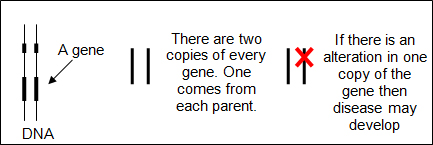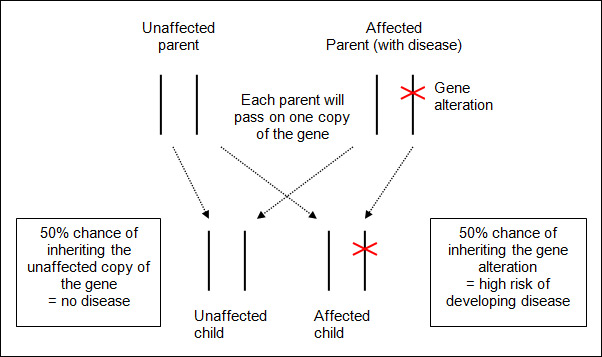Genetic Inheritance
Our body is made up of millions of cells. There are many different types of cells, including brain cells, liver cells and heart cells to name a few. Each cell contains 46 chromosomes, which hold the genetic material that decides our features such as the colour of our eyes and whether we are tall or short. These 46 chromosomes are grouped into 23 pairs, one of each pair coming from your mother and the other from your father. One of these pairs is known as the sex chromosomes, and these decide whether we are male or female.
If you imagine a chromosome as being like a ball of wool, you could stretch it out into one long strand, which is known as the DNA. Along the length of DNA there are regions called genes. As there are two copies of every chromosome, there are also two copies of every gene (one from each parent). Genes act as recipes to make certain things in the body, and each recipe is unique based on the order of units that make it up. If there is a mistake in one of these genes (a mix-up in the order of these units) it may cause disease. This mistake is known as a gene alteration or mutation.

In inherited heart conditions, one copy of a gene that is involved in keeping the heart healthy contains an alteration. This gene alteration changes the message sent out to the body and causes disease. This is known as Autosomal Dominant inheritance as you only need one copy of the gene to have an alteration for disease to develop. This type of inheritance affects males and females equally.
A person with the heart condition will have one copy of the gene with the alteration and one unaffected copy. If this person has children, each child will have a 1 in 2 or 50% chance of inheriting the altered gene copy. This is because they can either inherit the altered copy or the unaffected copy from the parent with the condition. The parent who does not have the condition will contribute the other copy of the gene (see diagram below).

Rarely, a person may have a gene alteration that has not been inherited from their parents. Instead, the alteration has arisen some time after conception (i.e. it has started in them). This means that their brothers and sisters are not likely to develop the disease, however the gene alteration can still be passed down to any children of the affected person.
Most inherited heart conditions show wide variation in symptoms among family members. For example, one person in a family may have severe disease while another from the same family may only have very mild symptoms.
It is important to remember that we cannot control what genes we pass on. There is nothing a person has done or did not do to pass on the gene alteration.
Genetic Testing
Genetic testing for some of the inherited heart conditions is now commercially available. Genetic testing is a two-step process. Firstly, a gene alteration must be identified in a family member who definitely has disease. This is a long process that has been likened to looking for a spelling mistake in a large instruction manual. There are many genes known to cause each of the inherited heart diseases and each family will have their own unique gene alteration (i.e. their spelling mistake may be in a different volume and page compared to another family with the same heart problem). For this reason, genetic testing is a very difficult and expensive task. It is possible that a family will undergo this type of testing and no gene alteration will be found. This does not mean that a gene alteration does not exist; just that it is likely to be in a gene that was not tested or is yet to be discovered. Further research is needed in this area to improve the speed of testing and increase the mutation identification rates in families.
If a gene alteration is found to be the cause of disease in your family, then other family members can be offered the gene test. This is a much faster test. It involves looking for the presence or absence of the family gene alteration, rather than searching through entire genes. This type of test, known as a predictive gene test, has the ability to identify family members that are likely to develop the familial heart problem sometime in the future.
Deciding to have predictive genetic testing is a very personal decision, and thinking about the consequences of the possible results can help in your decision. A POSITIVE result means that you do carry the gene alteration responsible for disease in your family. You therefore have a high risk of developing this disease in the future and your children have a 1 in 2 (50%) chance that they will inherit the gene alteration. A NEGATIVE result means that you do not carry the gene alteration and will not develop the heart disease in the family. In addition, you cannot pass it on to your children.
Prior to having a genetic test, it is important that you receive counselling from experts in cardiac genetics. Such specialist advice is available from clinical genetics services or a specialist cardiac genetic team. Your GP can refer you to such clinics. For more information about genetic testing in your family, contact a Cardiac Genetic Service near you.










